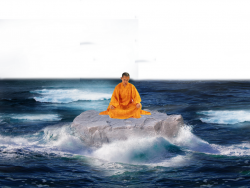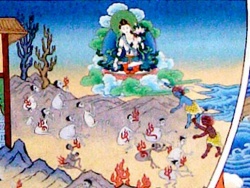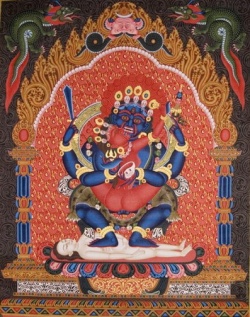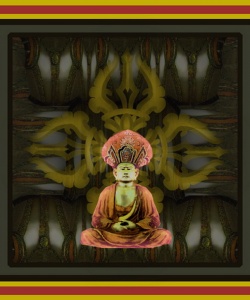Śūnyatā - Emptiness or Voidness
Nomenclature and etymology Śūnyatā (Sanskrit) is usually glossed as "emptiness" and is the noun form of the adjective "Shunya" (Sanskrit) which means "zero", literally zero "ness". In the Mūlamadhamaka kārikas[1] attributed to Nagarjuna, Śūnyatā is qualified as "...void, unreal, and non-existent". Eliot et al. (1993: p.81) in commenting on the aforecited qualification of Śūnyatā from De la Valée Poussin, furthers that:
None of these translations of śûnya is, however, quite satisfactory and there is much to be said for Stcherbatsky’s [[[Wikipedia:Fyodor Shcherbatskoy|Stcherbatsky]] (1927). The Conception of Nirvana.] rendering - relative or contingent. Phenomena are śûnya or unreal because no phenomenon when taken by itself is thinkable: they are all interdependent and have no separate existence of their own.
Exegesis
The teaching on the emptiness of all phenomena is a core basis of Buddhist philosophy/theology and has implications for epistemology and phenomenology. It also constitutes a metaphysical critique of Greek philosophical realism, Abrahamic monotheism and Hindu concept of atman. Moreover, contrary to widely misconceived equation to the doctrine of nihilism, grasping the doctrine of sunyata is seen as a step to liberation.
Śūnyatā signifies that everything one encounters in life is empty of absolute identity, permanence, or an in-dwelling ’self’. This is because everything is inter-related and mutually dependent - never wholly self-sufficient or independent. All things are in a state of constant flux where energy and information are forever flowing throughout the natural world giving rise to and themselves undergoing major transformations with the passage of time.
This teaching does not connote nihilism. In the English language the word emptiness suggests the absence of spiritual meaning or a personal feeling of alienation, but in Buddhism the realization of the emptiness of phenomena, at basic level, enables one to realise that the things which ultimately have no substance are trivial and not worthy of worry, conflict or antagonism.
Ultimately, true realisation of the doctrine bring liberation from the limitations of form in the cycle of uncontrolled rebirth.
Rawson states that: "[o]ne potent metaphor for the Void, often used in Tibetan art, is the sky. As the sky is the emptiness that offers clouds to our perception, so the Void is the ’space’ in which objects appear to us in response to our attachments and longings." The Japanese use of the Chinese character signifying Shunyata is also used to connote sky or air.
Origin and development of Śūnyatā
The theme of śūnyatā emerged from the Buddhist doctrines of Anatta (Pali, Sanskrit:Anātman—the nonexistence of the self, or Ātman) and Paticcasamuppada (Pali, Sanskrit: pratītyasamūtpāda, Interdependent Arising). The Suñña Sutta,[5] part of the Pali Canon, relates that the monk Ananda, the attendant to Gautama Buddha asked, "It is said that the world is empty, the world is empty, lord. In what respect is it said that the world is empty?" The Buddha replied, "Insofar as it is empty of a self or of anything pertaining to a self: Thus it is said, Ananda, that the world is empty." He goes on to explain that what is meant by "the world" is the six sense media and their objects, and elsewhere says that to theorize about something beyond this realm of experience would put one to grief.
Over time, many different philosophical schools or tenet-systems (siddhānta in Sanskrit)[6] have developed within Buddhism in an effort to explain the exact philosophical meaning of emptiness.
After the Buddha, Śūnyatā was further developed by Nāgārjuna and the Madhyamaka school, which is usually counted as an early Mahayana school. Śūnyatā ("positively" interpreted - see Tathagatagarbha section below) is also an important element of the Tathagatagarbha literature, which played a formative role in the evolution of subsequent Mahayana doctrine and practice. In the Tibetan Buddhist tradition, detailed dialogs between the perspectives of the various schools are preserved in order to train students. For example, in the Tibetan tradition some of the main philosophical schools are listed as: Vaibhasika, Sautrantika, Cittamatra, and several schools within Madhyamaka (such as Svatantrika-Madhyamika and Prasangika-Madhyamika).
It should be noted that the exact definition and extent of shunyata varies within the different Buddhist schools of philosophy which can easily lead to confusion. These tenet-systems all explain in slightly different ways what phenomena ’are empty of’, which phenomena exactly are ’empty’ and what emptiness means.
For example, some members of the Cittamatra school have held that the mind itself ultimately exists (the most prominent members of the school did not), but other schools like the Madhyamaka deny that either this statement or its negation has any validity.
In the Mahayana Tathagatagarbha sutras, in contrast, only impermanent, changeful things and states (the realm of samsara) are said to be empty in a negative sense - but not the Buddha or Nirvana, which are stated to be real, eternal and filled with inconceivable, enduring virtues.
Further, the Lotus Sutra states that seeing all phenomena as empty (sunya) is not the highest, final attainment: the bliss of total Buddha-Wisdom supersedes even the vision of complete emptiness.
Śūnyatā in presectarian Buddhism, in the Nikayas
Sunnata (Sanskrit: Śūnyatā, "Emptiness", is the noun form of Shunya (zero) in Sanskrit, literally zero "ness") in Pali contexts is not the metaphysical Zero (non-being as a principle of being, infinite possibility as distinguished from indefinite actuality), but a characteristic of this world.
In S IV.295, it is explained that a bhikkhu can experience a deathlike contemplation in which perception and feeling cease. When he emerges from this state, he recounts three types of "contact" (phasso): "emptiness" (suññato), "signless" (animitto) and "undirected" (appaṇihito). The meaning of the "emptiness" as contemplated here is explained at M I.297 and S IV.296-97 as the "emancipation of the mind by emptiness" (suññatā cetovimutti) being consequent upon the realization that "this world is empty of self or anything pertaining to self" (suññam idaṃ attena vā attaniyena vā). The term is also used in two suttas in the Majjhima Nikaya, where it is used in the context of a progression of mental states to refer to each state’s emptiness of the one below.
The stance that nothing contingent has any inherent essence forms the basis of the more sweeping ’sunyavada’ doctrine. In the Mahayana, this doctrine, without denying their value, denies any essence to even the Buddha’s appearance and to the promulgation of the Dhamma itself.
Post-Canonical Theravada
In the Patisambhidamagga, many meanings are given, including nirvana. Formations are said to be empty in/of/by own-nature, a similar expression to one used in Mahayana literature.
Emptiness is not taught as often by Theravada teachers as it is by Mahayanists. One reason for this is that emptiness is seen as a liberating insight in the Theravada tradition, rather than a philosophical view one needs to understand intellectually; emptiness is often not taught until the teacher decides the student is ready. Another is that in some circumstance where a Mahayanist would use the word "shunyata," a Theravadin would instead use the words "impermanence" or "anatta" to mean the same thing. A third is that in the Theravada tradition, understanding emptiness is subordinated to the ultimate goal of liberation.
Another view is that in advancing personal growth, it is not metaphysics but phenomenology that is required. Metaphysical views are often irrelevant, or even harmful if the intrinsic emptiness of the fruits of an unskillful act provide a rationale for performing that act.
For more on the the Buddha’s use of the idea of emptiness in its original phenomenological context and its use in the modern Thai Forest Tradition, see Thanissaro Bhikkhu, "Emptiness".
Mahayana
The ’Vajracchedika Sutra’ states the following: ’Those who see me in the body (rupena) and think of me in sounds (ghosaih), their way of thinking is false, they do not see me at all. ... The Buddha cannot be rightly understood (rjuboddhum) by any means (upayena)." Note that "means" are not dispositive to a right understanding, but that if regarded as ends, even the most adequate means are a hindrance. What is true of ethics is also true of the supports of contemplation on emptiness: as in the well known Parable of the Raft (Alagaddupama Sutra), the means of crossing a river are of no more use when the goal of the other shore has been reached.
Śunyata in the Heart Sutra
Śūnyatā is a key theme of the Heart Sutra (one of the Mahayana Perfection of Wisdom Sutras), which is commonly chanted by Mahayana Buddhists worldwide.
The Heart Sutra declares that the skandhas, which constitute our mental and physical existence, are empty in their nature or essence, i.e., empty of any such nature or essence. But it also declares that this emptiness is the same as form (which connotes fullness)—i.e., that this is an emptiness which is at the same time not different from the kind of reality which we normally ascribe to events; it is not a nihilistic emptiness that undermines our world, but a "positive" emptiness which defines it.
"The noble bodhisattva, Avalokitesvara, engaged in the depths of the practice of the perfection of wisdom, looked down from above upon the five skandhas (aggregates), and saw that they were empty in their essential nature. "Hear, O Sariputra, emptiness is form; form is emptiness. Apart from form, emptiness is not; apart from emptiness, form is not. Emptiness is that which is form, form is that which is emptiness. Just thus are perception, cognition, mental construction, and consciousness."
"Hear, O Sariputra, all phenomena of existence are marked by emptiness: not arisen, not destroyed, not unclean, not clean not deficient nor fulfilled."
Śūnyatā in Nāgārjuna’s Madhyamaka school
For Nāgārjuna, who provided the most important philosophical formulation of śūnyatā, emptiness as the mark of all phenomena is a natural consequence of dependent origination; indeed, he identifies the two. In his analysis, any enduring essential nature (i.e., fullness) would prevent the process of dependent origination, would prevent any kind of origination at all, for things would simply always have been and always continue to be.
This enables Nāgārjuna to put forth a bold argument regarding the relation of nirvāna and samsāra. If all phenomenal events (i.e., the events that constitute samsāra) are empty, then they are empty of any compelling ability to cause suffering. For Nāgārjuna, nirvāna is neither something added to samsāra nor any process of taking away from it (i.e., removing the enlightened being from it). In other words, nirvāna is simply samsāra rightly experienced in light of a proper understanding of the emptiness of all things.
Sunyata in the Tathagatagarbha Sutras
The class of Buddhist scriptures known as the Tathagatagarbha sutras presents a seemingly variant understanding of Emptiness. To counteract a possible nihilist view of someone who is disconcerted by the predominantly negative language of Madhyamaka, these sutras portray emptiness of certain phenomena in a positive way. According to some scholars, the "tathagatagarbha"/Buddha-nature these sutras discuss does not represent a substantial self (atman); rather, it is a positive language expression of emptiness and represents the potentiality to realize Buddhahood through Buddhist practices. In this view, the intention of the teaching of ’tathagatagarbha’/Buddha nature is soteriological rather than theoretical.
According to others, the potential of salvation depends on the ontological reality of a salvific, abiding core reality (the Buddha-nature, empty of all mutability and error) fully present within all beings.[14] According to Matsumoto Shiro and Hakamaya Noriaki, the latter is an un-Buddhist idea. The Mahayana Mahaparinirvana Sutra contains a passage in which the Buddha is portrayed castigating those who view the Tathagatagarbha (which is the indwelling, immortal Buddha-element) in each being as empty. The sutra states how the Buddha declares that they are effectively committing a form of painful spiritual suicide through their wrongheaded stance: "By having cultivated non-Self in connection with the Tathagatagarbha and having continually cultivated Emptiness, suffering will not be eradicated but one will become like a moth in the flame of a lamp."
( The Tibetan version of the Mahayana Mahaparinirvana Sutra). The attainment of nirvanic Liberation ("moksha"), by contrast, is said to open up a realm of "utter bliss, joy, permanence, stability, [and] eternity" (ibid), in which the Buddha is "fully peaceful" (Dharmakshema "Southern" version). In the period of the Tathagatagarbha genre, Mahayana metaphysics had been dominated by teachings on emptiness in the form of Madhyamaka philosophy. The language used by this approach is primarily negative, and the Tathagatagarbha genre of sutras can be seen as an attempt to state orthodox Buddhist teachings of dependent origination using positive language instead, to prevent people from being turned away from Buddhism by a false impression of nihilism. In these sutras the perfection of the wisdom of not-self is stated to be the true self; the ultimate goal of the path is then characterized using a range of positive language that had been used in Indian philosophy previously by essentialist philosophers, but which was now transmuted into a new Buddhist vocabulary to describe a being who has successfully completed the Buddhist path.
Professor C.D. Sebastian writes that the author of the Uttaratantra, a tathagatagarbha text, claims that the Emptiness teachings of the prajnaparamita scriptures are true yet incomplete, and that Sunyata needs the elucidation of tathagatagarbha doctrine, which is claimed by the author of the Uttaratantra to be a superior teaching:
‘The Uttaratantra is a Mahayana text with emphasis on Buddhist metaphysics and mysticism. And: ‘Tathagata-garbha thought is complementary to sunyata thought of the Madhyamika and the Yogacara, as it is seen in the Uttaratantra. The Uttaratantra first quotes the Srimala-devi-sutra to the effect that tathagata-garbha is not accessible to those outside of sunya realization and then proceeds to claim that sunyata realization is a necessary precondition to the realization of tathagata-garbha. There is something positive to be realized when one’s vision has been cleared by sunyata. The sunyata teachings of the prajna-paramita are true but incomplete. They require further elucidation, which is found in the Uttaratantra.’ And: ’The Uttaratantra speaks of Buddhahood or Buddha-nature. Thus it signifies soemthing special and different when we take into consideration the term tantra in the Uttaratantra. Further, as stated earlier, the sunyata teachings in the Prajnaparamita are true, but incomplete. They require still further elucidation, which the Uttaratantra provides. Thus it assumes the Prajna-paramita teachings as the purva or prior teachings, and the tathagata-garbha teachings as the uttara, in the sense of both subsequent and superior.’
Professor Sebastian also indicates that the Srimala Sutra can be seen as critical of negatively understood sunyata and that both the Srimala Sutra and the Uttaratantra enunciate the idea that the tathagatagarbha is possessed of four transcendental qualities and that the tathagatagarbha is ultimately identifiable as the dharmakaya (most exalted nature of the Buddha). These elevated qualities make of the Buddha one to whom devotion and adoration could be given:
‘This text is, in a way, highly critical of the negative understanding of sunyata. This text is one of the earliest Buddhist scriptures to be dedicated specifically to an exposition of the concept of the tathagata-garbha. The garbha possesses four guna-paramitas [qualities of perfection] of permanence, bliss, self, and purity, which can be seen in the Uttaratantra too. In the text, the garbha is ultimately identified with the dharmakaya of the tathagata. Here there is an elevation and adoration of Buddha and his attributes, which could be a significant basis for Mahayana devotionalism.








